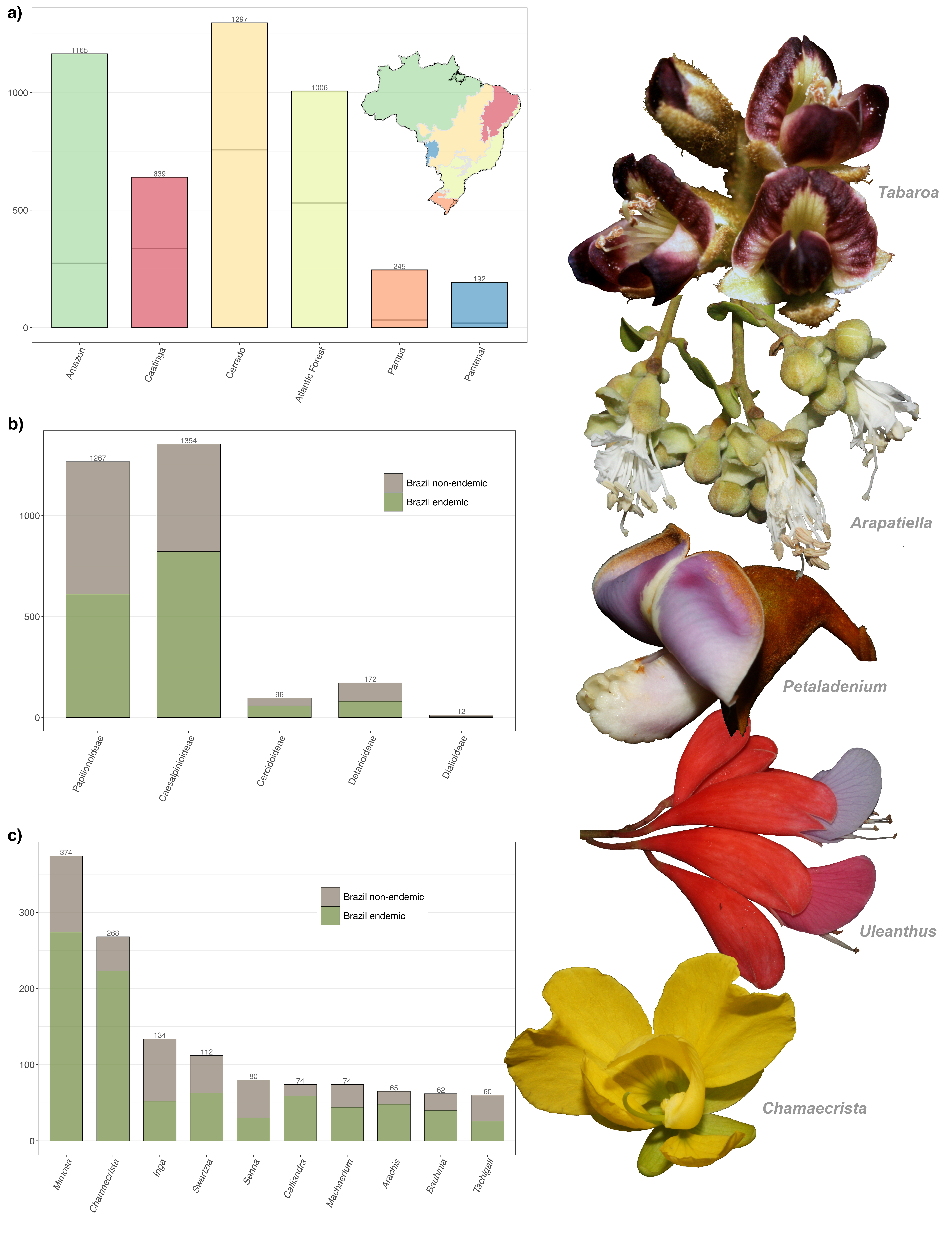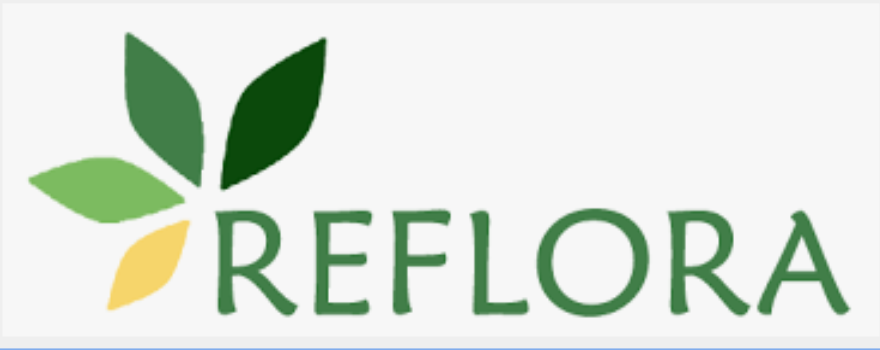Flora do Brasil 2020: Where does the Leguminosae Fit in the Megadiverse Brazilian Flora?
Marli Pires Morim1, Fabiana Filardi1, Domingos Cardoso2, Haroldo Cavalcante de Lima1 & Luciano Paganucci de Queiroz3
1Instituto de Pesquisas Jardim Botânico do Rio de Janeiro, Brazil
2Universidade Federal da Bahia, Brazil
3Universidade Estadual de Feira de Santana, Brazil
The Flora do Brasil 2020 project was started in 2008 by a collaborative network of Brazilian and international taxonomists, coordinated by the Rio de Janeiro Botanical Garden (JBRJ) and a scientific committee. The aim was to meet the 2010 – 2020 targets established by the Global Strategy for Plant Conservation (GSPC), under the umbrella and guidelines of the Convention on Biological Diversity (CBD). The initial phase, which became known as “List of Brazil” aimed to develop a working species checklist, with data on nomenclature (accepted names vs. synonyms) and geographic distribution for all species of plants, algae, and fungi occurring in Brazil. After successfully reaching the GSPC Target 1 in 2010, the elaboration of illustrated taxonomic online accounts for families and genera was established as the next objective to be achieved by the end of 2020. In both phases, from updating the species checklist to publication of the monographs of virtually all families that make up the extraordinary diversity of the Brazilian flora, the work was carried out on a fully online platform, where data were exclusively entered by taxonomic experts in the different plant groups.**
By the end of the Flora do Brasil 2020 project (http://floradobrasil.jbrj.gov.br/), 979 scientists, more than twice as many as during the first phase (“Lista do Brasil”), had committed to preparing monographs (BFG, 2021). This massive effort resulted in dissemination of data on nomenclature, life forms and geographic distributions for all 46,975 native species of algae (4,972 species), bryophytes (1,584), ferns and lycophytes (1,380), angiosperms (32,696), gymnosperms (23) and fungi (6,320), as well as completion of taxonomic accounts for almost all families and genera of land plants. The project revealed that 55% of the land plant species are endemic to Brazil which is home to about 10% of all land plant species ever described on the planet.
The Leguminosae stand out in the megadiverse Brazilian Flora as the family with the highest species richness and remarkable levels of endemism, with 220 genera/18 endemic and 2,901 species/1,576 endemic from across all the legume subfamilies, except Duparquetioideae (Fig. 1b). The ten most diverse genera are Mimosa (374 species), Chamaecrista (268), Inga (134), Swartzia (112), Senna (80), Calliandra (74), Machaerium (74), Arachis (65), Bauhinia (62) and Tachigali (60), which together comprise 45% of the total species diversity of Brazilian legumes (Fig. 1c).

Figure 1. Taxonomic diversity and endemism of Leguminosae in the Flora of Brazil. (a) Species diversity across the main Brazilian phytogeographic domains; the lower parts of the histogram below the lines represent the proportion of endemic species in each domain. (b) Species diversity and endemism for each legume subfamily. (c) The ten most species-rich genera. Flower images show representatives of a recently described monotypic endemic genus from the Caatinga (Tabaroa), a small endemic genus from the Atlantic Forest (Arapatiella), two monotypic Amazonian genera that had long remained poorly known (Petaladenium* and Uleanthus), and one of the most species-rich legume genera in Brazil (Chamaecrista).*
The Brazilian species of Leguminosae vary greatly in terms of growth forms, from giant trees and canopy lianas to tiny herbs across all different ecosystems within the main Brazilian phytogeographic domains. The Cerrado is home to the largest number of species (1,297 species), followed by the Amazon (1,165), Atlantic Forest (1,006), Caatinga (639), Pampa (245) and Pantanal (192) (Fig. 1a). The Atlantic Forest and Caatinga concentrate the largest number of endemic legume genera, with nine genera occurring exclusively in one or both of these phytogeographic domains. Most endemic genera are monotypic, for example, Arapatiella, Blanchetiodendron, Paubrasilia (Atlantic Forest), Tabaroa (Caatinga), Androcalymma, Petaladenium, Uleanthus (Amazon), and Sellocharis (Pampa) (Fig. 1).
The results obtained for Leguminosae in the context of the Flora do Brasil 2020 stem from the inputs and collaboration of 102 taxonomists (86% Brazilian and 14% international). Of the 220 genera that naturally occur in Brazil, 210 had their taxonomic accounts completed for the Flora do Brasil 2020, all of which can be accessed online at: (https://reflora.jbrj.gov.br/reflora/floradobrasil/FB115) or downloaded as PDF files from within the main publication called “Coleção Flora do Brasil 2020” (http://dspace.jbrj.gov.br/jspui/handle/doc/126). Although the complete account of all Leguminosae has not quite been finished yet, on the project page there is a comprehensive morphological description of the family, and identification keys for its subfamilies according to the newest phylogenetic classification (LPWG, 2017) and for all the genera with native, naturalized or cultivated species in Brazil. For each genus, field or herbarium images and information about its origin, distribution in the country, morphological features and key for species identification are provided.
The last decade has seen great advances in our knowledge of the diversity of the flora of Brazil, and the Leguminosae is no exception in this regard. However, biodiversity in many regions of the country is still poorly known, especially in the Amazon and Cerrado. Many legume species remain under-collected, phylogenetically enigmatic or still to be described and revealed to science. The “Flora do Brasil Online” project is continuing. The broad and fruitful collaborative network of legume taxonomists is continuing their joint efforts to finalize and continue updating all monographs. In addition to filling taxonomic knowledge gaps in the Brazilian flora, concerted efforts with the Legume Phylogeny Working Group (LPWG) and the recently launched Legume Data Portal (https://www.legumedata.org) will undoubtedly be important to meet the challenges of placing all Brazilian legumes in a robust molecular phylogeny of the family and understanding their patterns of geographic distribution in a global context.
References:
The Brazil Flora Group [BFG] (2021) Flora do Brasil 2020. pp. 1–28. Jardim Botânico do Rio de Janeiro, Rio de Janeiro. http://doi.org/10.47871/jbrj2021001
The Legume Phylogeny Working Group [LPWG] (2017) A new subfamily classification of the Leguminosae based on a taxonomically comprehensive phylogeny. Taxon, 66: 44–77. https://doi. org/10.12705/661.3
Additional Readings:
Forzza RC, Baumgratz JFA, Bicudo CEM, Canhos DAL, Carvalho Jr. AA, Costa A, Costa DP, Hopkins M, Leitman PM, Lohmann LG, NicLughadha E, Maia LC, Martinelli G, Menezes M, Morim MP, Coelho MAN, Peixoto AL, Pirani JR, Prado J, Queiroz LP, Souza S, Souza VC, Stehmann JR, Sylvestre LS, Walter BMT, Zappi D (2012) New Brazilian floristic list highlights conservation challenges. BioScience 62: 39–45. https://doi.org/10.1525/bio.2012.62.1.8
The Brazil Flora Group [BFG] (2015) Growing knowledge: An overview of seed plant diversity in Brazil. Rodriguésia, 66: 1085–1113. http://doi.org/10.1590/2175-7860201566411
The Brazil Flora Group [BFG] (2018) Brazilian Flora 2020: Innovation and collaboration to meet Target 1 of the Global Strategy for Plant Conservation (GSPC). Rodriguésia, 69: 1513–152. http://doi.org/10.1590/2175-7860201869402
The Brazil Flora Group [BFG] (2021) Coleção Flora do Brasil 2020. pp. 1–36. Jardim Botânico do Rio de Janeiro, Rio de Janeiro. http://doi.org/10.47871/jbrj2021004
The Brazil Flora Group [BFG] (2022) Brazilian Flora 2020: Leveraging the power of a collaborative scientific network. Taxon, 71: 178–198. https://doi.org/10.1002/tax.12640
Footnote**
For more details about the historical background and results of the Flora do Brasil 2020 project, visit the website http://dspace.jbrj.gov.br/jspui/handle/doc/118. To download any taxonomic account in PDF format, including the many that are already finished for the legume genera, access http://dspace.jbrj. gov.br/jspui/handle/doc/126. Furthermore, the data assembled on richness and occurrences of Brazilian plant and fungi species are available for download at: http://ipt.jbrj.gov.br/jbrj/resource?r=lista_especies_flora_brasil, while the morphological data obtained from the taxonomic accounts have also been integrated into the World Flora Online project (http://www.worldfloraonline.org/).
